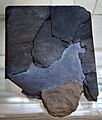Šuppiluliuma I facts for kids
Suppiluliuma I was a powerful king of the Hittites, ruling around 1370–1330 BC. He became famous as a great warrior and a smart leader. He successfully challenged the mighty Egyptian Empire for control of lands between the Mediterranean Sea and the Euphrates River.
Contents
Becoming King
Suppiluliuma was the son of King Tudhaliya II. He started his career as a top advisor and general for his father. In this role, he fought and defeated the Hittites' enemies, like the Kaskas and the Azzi-Hayasa people. He was so successful that the Hittite court could safely return to its capital city, Hattusa.
When his father, Tudhaliya II, died, Suppiluliuma's older brother, Tudhaliya the Younger, became king. However, Suppiluliuma soon took the throne from his brother. Later, some Hittite priests told Suppiluliuma's son, Mursili II, that this was a big mistake by the royal family.
Suppiluliuma's Rule
King Suppiluliuma made important alliances by marrying his sister to the Hayasan king Hukkana. He also married his daughter Muwatti to Maskhuiluwa, a ruler from the Arzawan state of Mira. He even married a princess from Babylonia.
One of his biggest victories was against the Mitanni kingdom. He made Mitanni a smaller state that had to obey him, placing his son-in-law Shattiwazza in charge. Suppiluliuma was also skilled at building large stone structures decorated with carvings. During his time, people started to believe that kings were sacred or special.
He took advantage of a difficult time in Egypt, when Pharaoh Akhenaten was ruling. Suppiluliuma took control of Egyptian lands in Syria, encouraging many smaller states to rebel against Egypt.
The Egyptian Princess
After the Egyptian king Nibhururiya (who was likely Tutankhamun) died, his wife, known as Dakhamunzu, wrote to Suppiluliuma. She asked him to send one of his sons to marry her and rule Egypt. She had no heir and didn't want to be forced to marry someone she considered a "servant."
Suppiluliuma sent an ambassador to check if her story was true. When he found out it was, the Hittite king decided to take this amazing opportunity. Sadly, his son, Prince Zannanza, died on the way to Egypt. This meant the marriage alliance never happened.
Suppiluliuma and the new Egyptian Pharaoh, Ay, exchanged angry letters. Suppiluliuma was furious, believing his son had been murdered by Egyptians. He then sent his armies to attack Egypt's allied states in Canaan and Northern Syria, taking over much land.
Unfortunately, many Egyptian prisoners carried a terrible disease. This plague spread to the Hittite homeland and eventually caused the deaths of both Suppiluliuma I and his son, Arnuwanda II.
His Family
Suppiluliuma I had two wives. His first queen was named Henti. Some texts suggest that she might have been sent away by her husband, possibly because he wanted to marry a Babylonian princess for political reasons. Henti was likely the mother of all his sons.
His sons included:
- Arnuwanda II, who became king after him.
- Telipinu, who became a priest.
- Piyassili, also known as Sarri-Kusuh, who governed the land of Hanigabat.
- Mursili II, who also became a powerful Hittite king.
- Zannanza, the prince who died on his way to Egypt.
After Henti, Suppiluliuma's next queen was a Babylonian princess named Malnigal. She was the daughter of King Burna-Buriash II.
Suppiluliuma also had at least one daughter named Muwatti.
In Stories and Books
Suppiluliuma I appears in different works of fiction:
- In Mika Waltari's historical novel The Egyptian, he is shown as a cruel conqueror.
- Janet Morris wrote a detailed novel about him called I, the Sun.
- He is a character in Philip Armstrong's novel The Shadow Prince, where he is the hero's grandfather.
- He also appears in the historical fiction manga Red River as an old man.
See also
 In Spanish: Suppiluliuma I para niños
In Spanish: Suppiluliuma I para niños
- Piyashshili
- Suppiluliuma II
- Zita (Hittite prince), brother of Suppiluliuma
Images for kids







